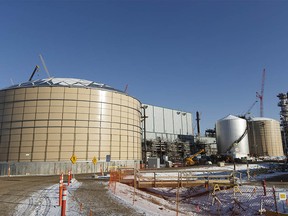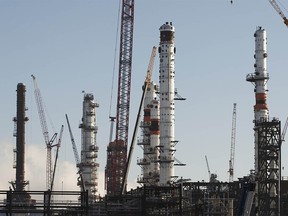
For possible sale: Part-ownership in an Alberta government megaproject.
Still relatively new, this refinery adds value to Alberta’s natural resources, but it’s also lost big money for the province.
Serious offers only. Contact Premier Danielle Smith’s office, if interested.
I thought I’d give the government some free help crafting an online advertisement as Alberta’s premier says she’s looking for options to stem the province’s recent losses from the Sturgeon Refinery.
Smith says one alternative she’d like to explore is the province selling its 50 per cent stake in the refinery.
“I wish the deal had been done differently . . . I have asked my energy (deputy minister) to look into it — is can we get to a different type of approach where some private sector operator will buy this from us, take it off our hands and we can guarantee them a long-term supply of bitumen?” Smith said in a recent interview.
“It’s just exposed us to too much risk.”
Alberta Energy is expected to provide possible options to the premier’s office in the spring of 2024.
Sanctioned in 2012, the $10-billion development was the first refinery built in Canada in more than 30 years, part of ongoing provincial efforts to add value to Alberta’s growing supply of bitumen.
First backed by Ed Stelmach’s government in the early part of last decade, construction began in 2013 in Sturgeon County, northeast of Edmonton.
-
 Varcoe: Alberta now owns part of an oil refinery, another stake in a mega-project for the province
Varcoe: Alberta now owns part of an oil refinery, another stake in a mega-project for the province -
 Alberta extends Sturgeon Refinery deal by 10 years, buying 50 per cent stake in bid to save $2 billion
Alberta extends Sturgeon Refinery deal by 10 years, buying 50 per cent stake in bid to save $2 billion -
 This may be the most perfect carbon innovation yet
This may be the most perfect carbon innovation yet
The refinery was designed to process about 79,000 barrels per day of diluted bitumen into ultra-low sulphur diesel and other products. It also includes a carbon capture and storage component.
At the time, the former PC government agreed to a 30-year deal to supply 75 per cent of the bitumen feedstock to the refinery, which would be turned into higher-value products like diesel.
It agreed to pay a processing toll to the owner and operator North West Redwater Partnership, then jointly owned by North West Refining and Canadian Natural Resources.
The province is obligated to pay a monthly toll, which is made up of debt repayment, debt servicing costs and an operating component.
But the refinery’s price tag climbed considerably, from $5.7 billion to $10 billion.
In 2017, the facility began producing diesel from synthetic crude. It started processing bitumen for the government in June 2020. However, higher capital costs led to higher tolls, making it more difficult for the province to make a profit.
As a study by Alberta’s auditor general bluntly stated in 2018, because of the structure of the agreement, “there is no plausible scenario where it would make financial sense to pull out of it.”
During the province’s mid-year update in November, the government forecasted its net loss from the refinery at $283 million this fiscal year, instead of $31 million of net income initially estimated in last February’s budget.
It cited a drop in forecast refined product prices and higher feedstock costs.
“Ultimately if you have a long enough time horizon — call it 40 years — I think the debt will be paid off and it will ultimately be making money. But short term, there’s a lot of pain,” the premier said.
“We have to find a way to bridge that gap and hopefully find some better long-term solutions so that we’re not on the hook for any losses in the future.”
Various governments over the past decade have also looked for ways to limit the red ink for the province.
In 2021, the Kenney government announced it would acquire a 50-per-cent equity share in the refinery through the Alberta Petroleum Marketing Commission (APMC), holding the stake previously owned by North West Refining.
As part of that agreement, the province extended the bitumen processing agreement by another 10 years to 2058.
At the time, then-energy minister Sonya Savage said that by taking an equity position and being able to renegotiate debt and mitigate risk, the change would save an estimated $2 billion over the long term.
In an interview this week, Savage said the changes gave the province more say in the operation and positioned taxpayers to benefit from any future upside in the project.
“It was a bad deal when it was first entered into in 2012, done for a good reason . . . to have more value-added and upgrading in Alberta,” Savage said.
“There were just no legal options to get out.”

According to Alberta Energy, the refinery completed its first scheduled major turnaround in the 2022-23 fiscal year, which contributed to a nearly $472-million net loss last year being recognized by APMC, as a toll payer and partner.
In a recent statement, the department pointed to the price differential for Western Canada Select (WCS) heavy oil compared with U.S. benchmark crude as one of several factors behind the expected losses this year.
However, third-quarter revenues have improved as a result of wider differentials recently, which sat around $20 a barrel this week.
“We want to get back to something simple. If we can guarantee, ‘Here you go, here’s the number of barrels, long-term supply, you upgrade it for us and take it to the market,’ then I think that would be a cleaner way of us engaging in that operation,” Smith said.
“I would love to sell it and be done with it. But I also know that it’s got a very big price tag on it because it had cost overruns.”
In the middle of December, the government signed an order-in-council, giving APMC the authority to borrow up to $2.9 billion for the financing and operation of the Sturgeon Refinery. The previous borrowing limit was $1.8 billion.
As of last March, APMC had borrowed $1.3 billion to fund contractual obligations.
“We are having ongoing conversations with . . . our operating partner on Sturgeon to do everything we can to improve the efficiency and profitability of the refinery,” Energy Minister Brian Jean said Tuesday in a statement.
But what options does the province have moving forward?

Former APMC chief executive Richard Masson, now an executive fellow at the University of Calgary’s School of Public Policy, doesn’t anticipate a sale of the province’s stake is in the cards.
Yet, the refinery still provides a partial hedge for Alberta when the price differential widens on Western Canadian Select heavy crude, Masson noted. As the economy continues to grow, Alberta will need more diesel.
“Alberta decided to get involved in this business,” Masson added.
“It took on a lot of risk in doing it, and it will have to live with the consequences for many, many years.”
Chris Varcoe is a Calgary Herald columnist.
You can read more of the news on source



